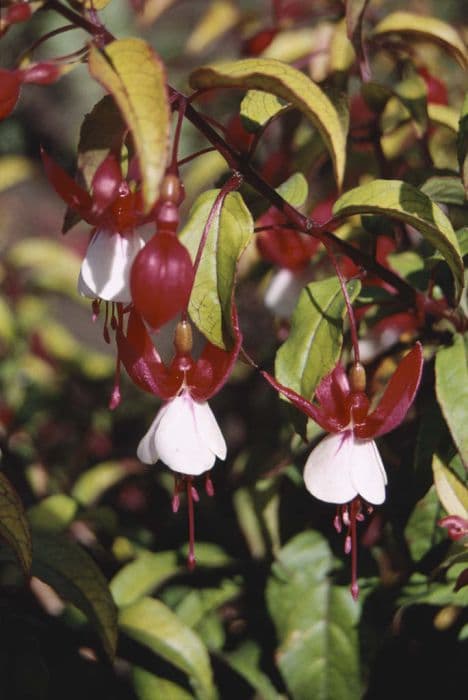Fuchsia Fuchsia 'White Pixie'

ABOUT
Fuchsia 'White Pixie' is a charming flowering plant known for its distinctive and attractive blooms. The flowers are a key feature, typically bicolored, with a white corolla, which is the inner ring of petals, and pink or light purple sepals that gracefully curve back from the corolla like elegant ballet dancers’ legs. These sepals are the outer parts of the flower and provide a delicate contrast to the white petals within. The flowers dangle like pendants from the branches, giving them an appearance reminiscent of lanterns or ballerina skirts. The foliage of White Pixie consists of small, oval-shaped leaves that are a deep green in color, providing a lush backdrop for the flowers. These leaves might have a slight sheen to them and are arranged oppositely on the stems, creating a full-bodied, bushy look. The plant's overall form is graceful and arching, with branches that may have a tendency to weep or trail, contributing to its whimsical, fairy-like presence in the garden. Throughout the blooming season, Fuchsia 'White Pixie' can be a prolific producer of flowers, which, in addition to their beauty, can attract hummingbirds and other pollinators to the garden. As a popular ornamental, it is often used in hanging baskets, containers, and in garden beds, where its distinctive flowers can truly shine and add a touch of elegance to the setting.
About this plant
 Names
NamesFamily
Onagraceae
Synonyms
White Pixie Fuchsia, Fuchsia 'White Pixie'
Common names
Fuchsia 'White Pixie'
 Toxicity
ToxicityTo humans
Fuchsia 'White Pixie', commonly known as White Pixie, is not considered toxic to humans. Ingesting this plant typically does not lead to poisoning or any serious health consequences.
To pets
White Pixie is generally considered non-toxic to pets as well. It is unlikely that ingestion would cause significant symptoms of poisoning in animals such as cats and dogs, and it is not known to lead to severe health issues. However, as with any non-food plant, individual animals might have mild reactions such as gastrointestinal upset if they consume large quantities.
 Characteristics
CharacteristicsLife cycle
Perennials
Foliage type
Deciduous
Color of leaves
Green
Flower color
White
Height
1-1.5 feet (30-45 cm)
Spread
1-2 feet (30-60 cm)
Plant type
Shrub
Hardiness zones
9
Native area
Central and South America
Benefits
 General Benefits
General Benefits- Ornamental Value: Fuchsia 'White Pixie' exhibits striking pendulous flowers that are visually appealing in hanging baskets, containers, and garden beds.
- Attracts Pollinators: Its blossoms attract hummingbirds and butterflies, providing food for them and aiding in pollination of the garden.
- Shade Tolerance: This variety of fuchsia can thrive in partial shade, making it suitable for garden spots that don't receive full sun.
- Compact Growth: 'White Pixie' is a compact plant, which makes it ideal for small gardens or limited spaces.
- Continuous Blooming: It produces a long-lasting display of flowers from early summer to fall, offering a prolonged period of visual interest.
 Medical Properties
Medical PropertiesThis plant is not used for medical purposes.
 Air-purifying Qualities
Air-purifying QualitiesThis plant is not specifically known for air purifying qualities.
 Other Uses
Other Uses- Artistic inspiration - Fuchsia flowers, with their unique shape and colors, can inspire artists and be featured in paintings, drawings, and textile designs.
- Fairy gardens - Due to their small size and delicate appearance, White Pixie fuchsias can be a whimsical addition to fairy garden compositions.
- Photography subject - The intricate and vibrant flowers of the fuchsia can be a captivating subject for macro photography.
- Educational tool - Fuchsias can be used to teach children or gardening enthusiasts about plant growth habits, pollination, and botany.
- Living jewelry - Small fuchsia blossoms can be used in making living corsages, earrings, or pendants for special events.
- Culinary decoration - Edible fuchsia flowers can be used to garnish cakes, desserts, and cocktails, although always check for specific edibility.
- Plant breeding - Gardeners can use fuchsias like the White Pixie for hybridizing, aiming to create new varieties with unique characteristics.
- Bonsai - Fuchsia plants can be trained into miniature bonsai trees, providing a unique challenge for enthusiasts.
- Seasonal celebrations - Fuchsia flowers can be integrated into holiday decor, especially for spring-themed events due to their lively appearance.
- Color dye - Historically, the vibrant colors of some fuchsia species may have been used to create natural dyes for fabrics, although it is not a common use today.
Interesting Facts
 Feng Shui
Feng ShuiThe Fuchsia is not used in Feng Shui practice.
 Zodiac Sign Compitability
Zodiac Sign CompitabilityThe Fuchsia is not used in astrology practice.
 Plant Symbolism
Plant Symbolism- Elegance: The delicate, balletic appearance of the Fuchsia 'White Pixie' symbolizes grace and poise.
- Good Taste: The unique and tasteful coloration of the white and pink hues embodies personal preference and sophistication.
- Confiding Love: Traditionally, fuchsias are associated with trust and confiding love, representing deep emotional connections.
- Amenability: The easy-to-grow nature of this plant suggests a symbol of willingness and flexibility in relationships.
- Absolute Purity: The clear white petals of this cultivar are often linked with purity and innocence.
 Water
WaterFuchsia 'White Pixie', commonly known as the White Pixie Fuchsia, should be watered thoroughly, but infrequently, to maintain moist but not soggy soil. During the growing season, water when the top inch of soil feels dry to the touch, roughly every 7 to 10 days, though this may vary with climate and indoor conditions. Use room temperature water and aim to provide between half a gallon and a gallon each time, depending on the size of the plant and container, ensuring excess water is allowed to drain away to avoid root rot. Reduce watering in the winter dormant period to every 3 to 4 weeks, but do not let the soil dry out completely. Always check the soil's moisture level before watering to adjust the routine accordingly.
 Light
LightWhite Pixie Fuchsia thrives in bright, indirect light. It’s important to keep the plant in a location where it receives morning sunlight but is shielded from the harsh afternoon sun, such as near an east-facing window. A shaded patio or a spot under a canopy that provides filtered light are also good locations, avoiding direct midday sunlight which can scorch the delicate leaves of the plant.
 Temperature
TemperatureWhite Pixie Fuchsia prefers a temperature range between 60 to 70 degrees Fahrenheit during the day and slightly cooler at night, but no lower than 50 degrees Fahrenheit. It is sensitive to extreme temperature changes and cannot survive in temperatures below 30 degrees Fahrenheit or above 80 degrees Fahrenheit. The ideal temperature conditions for this plant allow for robust growth and abundant blooms, so maintaining a consistent temperature within this range is essential for its health.
 Pruning
PruningPruning White Pixie Fuchsia is essential for maintaining a bushy and healthy shape, as well as promoting vigorous flowering. Prune the plant in late winter or early spring before new growth begins, trimming back by a third to encourage branching. Deadhead spent flowers regularly to encourage continuous blooming throughout the summer. Occasionally, light pruning can be done during the growing season to remove any broken or dead stems and to shape the plant.
 Cleaning
CleaningAs needed
 Soil
SoilFuchsia 'White Pixie', commonly known as Fuchsia, thrives in a well-draining soil mix rich in organic matter with a pH between 6-7. A mixture of peat moss, perlite, and loam works well to provide the necessary drainage and aeration. Regular fertilization during the growing season will help maintain vibrant growth and blooms.
 Repotting
RepottingFuchsia 'White Pixie' should be repotted annually or when rootbound. It's best to repot in the spring just before new growth begins, using fresh soil mix to replenish nutrients and encourage healthy development.
 Humidity & Misting
Humidity & MistingFuchsia 'White Pixie' benefits from high humidity levels, generally around 60-70%. They thrive in moist air environments, which can be achieved by using a humidifier or placing a water tray near the plant to enhance ambient moisture.
 Suitable locations
Suitable locationsIndoor
Place in bright, indirect light with high humidity.
Outdoor
Plant in partial shade, sheltered from intense sun.
Hardiness zone
6-11 USDA
 Life cycle
Life cycleFuchsia 'White Pixie' starts its life as a seed, initially germinating in warm, moist soil conditions in the spring. As a seedling, it slowly develops roots and a pair of true leaves, readying itself for more robust growth. The vegetative stage is marked by the emergence of its distinctive foliage and stems, growing actively during the warmer months. As it matures, this perennial enters the flowering stage, where it produces its characteristic white blossoms that dangle elegantly, attracting pollinators. After pollination, it may produce small fruits with seeds, completing the reproductive cycle. In colder climates, Fuchsia 'White Pixie' enters a dormant period during the winter, only to rejuvenate and restart its cycle with the return of favorable conditions.
 Propogation
PropogationPropogation time
Spring-Early Summer
Fuchsia 'White Pixie', commonly known as White Pixie Fuchsia, can be propagated primarily by stem cuttings. The best time for this is late spring to early summer when the plant is actively growing. To propagate by cuttings, take healthy, non-flowering shoots of about 2-4 inches (5-10 cm) in length and strip the lowest leaves. Dip the cut end of the shoot into rooting hormone powder to stimulate root growth. Plant the cutting in a pot filled with a moistened mixture of peat and perlite or a seed-starter type of soil. Enclose the pot in a plastic bag or place it in a propagator to maintain high humidity, and keep it in a warm spot with indirect light. Roots typically develop in 3 to 4 weeks, after which the new plants can be gradually acclimated to normal conditions.









